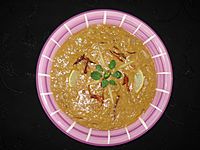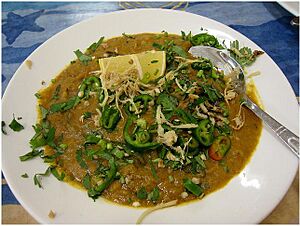Haleem facts for kids

Hyderabadi haleem from India , garnished with fried onions, egg, cilantro, and lime.
|
|
| Region or state | Indian subcontinent, Central Asia, Middle East |
|---|---|
| Serving temperature | Hot |
| Main ingredients | Wheat, barley, lentils, meat |
| Variations | Keşkek, harisa, khichra |
Haleem is a thick and hearty stew that is popular in many parts of the world, especially in the Indian subcontinent, the Middle East, and Central Asia. It's a special dish made by slow-cooking grains like wheat and barley with meat and lentils. The ingredients are often blended or mashed together to create a smooth, paste-like texture. Haleem is usually served hot, sometimes with flatbreads.
There are many different kinds of haleem. For example, keşkek is a similar dish found in Turkey and parts of Central Asia. Another version, called harisa, is popular in the Arab world. In Iran, West Bengal, and Bangladesh, it's known as halim. In Pakistan and India, you might find a version called khichra.
Contents
How Haleem is Made

Haleem is made from four main parts:
- Grains: Wheat or barley are almost always used. Sometimes, other pulses (like lentils) and rice are added, depending on the recipe.
- Meat: This can be beef, lamb, goat meat, or chicken.
- Spices: A wide range of spices are used, such as cassia and fennel, to give it a rich flavor.
- Liquid: Water, milk, or a meat broth is used for cooking.
This stew is cooked slowly for many hours, usually seven to eight. After cooking, it's stirred or beaten very strongly with a special stick, like a pestle. This process makes the dish thick and smooth, blending all the flavors of the spices, meat, barley, and wheat.
To make traditional haleem, wheat, barley, and gram lentils are soaked overnight. Then, a spicy meat gravy called korma is prepared until the meat is very soft. The soaked grains and lentils are boiled until tender. Finally, these cooked grains and lentils are mixed with the meat gravy and blended until they become a smooth paste. This whole process can take about six hours. Once it's ready, haleem is often topped with fried onions, thin slices of ginger, green chilies, coriander leaves, lemon wedges, and a spice mix called chaat masala.
Where Haleem Comes From
Haleem's story begins with an old Arabian dish called Harees. The first written recipe for Harees was found in a cookbook from the 10th century. This cookbook was put together by an Arab writer named Abu Muhammad al-Muzaffar ibn Sayyar in Baghdad. The recipe described in his book, Kitab Al-Tabikh, is very similar to the Harees eaten in the Middle East today. As the Arab empire grew, Harees spread to many different parts of the world.
Harees came to the Indian subcontinent through Arab soldiers who were part of the Hyderabad Nizam's army. Even today, you can find Harees in the Arab area of Hyderabad called Barkas. Over time, the people of Hyderabad changed the recipe to fit their own tastes, and that's how modern haleem was created.
Cultural Importance
Haleem is a popular snack food sold in markets all year round. It's also a very special dish made during the Ramadan and Muharram months of the Hijri calendar. Many Pakistanis and Indian Muslims enjoy it during these times.
In Hyderabad, haleem made during Ramadan is so famous that it's sent all over the world using special delivery services. It's often cooked in huge pots over wood fires, which adds to its unique flavor.
Haleem is also very popular in Bangladesh, especially during Ramadan. The Bangladeshi version, sometimes called "Shahi Halim," is a bit different. The meat and bones are stewed in small pieces instead of being mashed completely into the lentil soup. Also, the spices used can be different.
In Pakistan, haleem is available throughout the year. You can find it as a street food in markets and in many Pakistani restaurants around the world.
Some Persian Jews have a tradition of eating haleem on Shabbat. This is because, like other Shabbat stews, it's a slow-cooked dish that can be prepared before Shabbat begins and then cooked slowly overnight.
Hyderabadi Haleem
Haleem has become a very popular dish in the cities of Hyderabad, Telangana, and Aurangabad, Maharashtra in India. It came to this region during the Mughal period through people who migrated from other countries.
In 2010, Hyderabadi haleem received a special award called "Geographical Indication" (GI) status from the Indian GI registry office. This was a big deal because it was the first meat product in India to get this certification. It means that if a dish is called "Hyderabadi haleem," it must meet certain quality standards.
Haleem vs. Khichra
In the Indian subcontinent, both haleem and khichra are made with similar ingredients. The main difference is in how the meat is prepared. In khichra, the meat stays in chunks or cubes. But in haleem, the meat is taken out of the pot, the bones are removed, and the meat is then crushed. After that, the crushed meat is put back into the pot and cooked more until it completely blends with the lentils, wheat, and barley mixture, making it very smooth.
Nutrition Facts
Haleem is a dish that provides a lot of energy. It gives you protein from the meat and fiber and carbohydrates from the different grains and pulses used to make it.
How to Serve Haleem
Haleem is often served with various toppings to add more flavor and texture. These can include chopped mint leaves, lemon juice, coriander leaves, fried onions, chopped ginger root, or green chilies. In some parts of Pakistan, people enjoy haleem with Naan bread or with rice.
See also
 In Spanish: Haleem para niños
In Spanish: Haleem para niños







